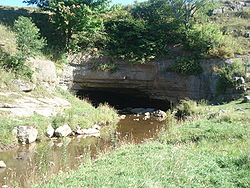
Greenbrier Limestone
Encyclopedia

Limestone
Limestone is a sedimentary rock composed largely of the minerals calcite and aragonite, which are different crystal forms of calcium carbonate . Many limestones are composed from skeletal fragments of marine organisms such as coral or foraminifera....
unit deposited during the Middle Mississippian Epoch (345.3 ± 2.1 – 326.4 ± 1.6 Ma), part of the Carboniferous Period
Carboniferous
The Carboniferous is a geologic period and system that extends from the end of the Devonian Period, about 359.2 ± 2.5 Mya , to the beginning of the Permian Period, about 299.0 ± 0.8 Mya . The name is derived from the Latin word for coal, carbo. Carboniferous means "coal-bearing"...
. This rock stratum
Stratum
In geology and related fields, a stratum is a layer of sedimentary rock or soil with internally consistent characteristics that distinguish it from other layers...
is present below ground in much of West Virginia
West Virginia
West Virginia is a state in the Appalachian and Southeastern regions of the United States, bordered by Virginia to the southeast, Kentucky to the southwest, Ohio to the northwest, Pennsylvania to the northeast and Maryland to the east...
and neighboring Kentucky
Kentucky
The Commonwealth of Kentucky is a state located in the East Central United States of America. As classified by the United States Census Bureau, Kentucky is a Southern state, more specifically in the East South Central region. Kentucky is one of four U.S. states constituted as a commonwealth...
, and extends somewhat into adjacent western Maryland
Maryland
Maryland is a U.S. state located in the Mid Atlantic region of the United States, bordering Virginia, West Virginia, and the District of Columbia to its south and west; Pennsylvania to its north; and Delaware to its east...
and southwestern Virginia
Virginia
The Commonwealth of Virginia , is a U.S. state on the Atlantic Coast of the Southern United States. Virginia is nicknamed the "Old Dominion" and sometimes the "Mother of Presidents" after the eight U.S. presidents born there...
. The name derives from the Greenbrier River
Greenbrier River
The Greenbrier River is a tributary of the New River, long, in southeastern West Virginia, USA. Via the New, Kanawha and Ohio Rivers, it is part of the watershed of the Mississippi River, draining an area of...
in West Virginia.
Greenbrier Limestone is in some places more than 400 feet (120 metres) thick, allowing it to trap large quantities of oil and gas. Since this carbonate rock
Carbonate rock
Carbonate rocks are a class of sedimentary rocks composed primarily of carbonate minerals. The two major types are limestone, which is composed of calcite or aragonite and dolostone, which is composed of the mineral dolomite .Calcite can be either dissolved by groundwater or precipitated by...
erodes quickly in the region's wet climate, outcrops are not prominent and are often quarried.
The Greenbrier Limestone is subdivided into six stratigraphic units. In ascending order, they are Denmar Limestone, Taggard Shale, Pickaway Limestone, Union Limestone, Greenville Shale, and Alderson Limestone. The limestones in this interval are predominantly skeletal grainstone
Grainstone
Under the Dunham classification, grainstones are grain-supported carbonate sedimentary rocks that contain no micrite. The spaces between grains are filled with sparry cement.-References:...
s or packstones. The Pickaway and especially the Union contain oolitic
Oolite
Oolite is a sedimentary rock formed from ooids, spherical grains composed of concentric layers. The name derives from the Hellenic word òoion for egg. Strictly, oolites consist of ooids of diameter 0.25–2 mm; rocks composed of ooids larger than 2 mm are called pisolites...
grainstones.
Numerous solution caves are developed within the Greenbrier Formation.

